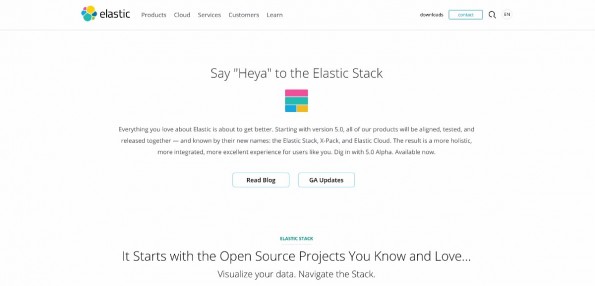When Bayerischer Rundfunk (BR) makes the software development department now a central role in deciding how messages are collected and presented. The public broadcaster of Bavaria belongs to a Germany-wide group and can point to eight million viewers and listeners daily. The broadcaster employs over 5,000 professionals, divided into ten radio stations and two television stations. The company also has two internationally renowned orchestra and a choir.
The software development department of the BR works like a startup, because she has freedom for experimentation and innovative approach. The huge audience of the transmitter also provides them with the resources they need for results. And in the face of large, data-driven newsrooms way to do the testing of new technology innovation with the freedom and resources.
Our guest author with Mustafa Isik, the Head of Software Development and Platforms at BR, on innovation spoken in software development and learn moreover how the BR the Elastic stack uses to tackle the next big data challenge.
as Isik came to BR, he still had no idea of broadcasting, because he was in the world of technology giants like Google home. As a confessed “hardcore geek” to Isik set about many other geeks around himself.
At the beginning of the team immediately realized that the public broadcasting their way into the “territory” of the modern Internet had not yet trodden. Isik realized that the until now were some obstacles. But he also recognized that this step now had to be done quickly in order to continue to fulfill the democratic role of the BR as a public broadcaster can. Isiks department was determined to play a leading role in shaping the future of broadcasting.
“We should not fight, but to embrace the change.”
– Mustafa Isik
“If we do not welcome the changes and not shape the paradigm shift that is happening in the broadcast media or the media in general, we will continue our lose significance for society, and that will have a negative impact on society, “says Isik while facing the public service broadcasting in Europe and the open education the priority private system in the US. The BR has a responsibility to society to act and equating equal entitling. This goes well with the Bavarian Broadcasting Act Compliant, which states that the program of BR “[...] [should] be taken of cultural responsibility, humanity and impartiality [...]” (Art. 4 BayRG).
the director of the Bavarian Radio, Ullrich Wilhelm, also his finger had in the game when it came to the creation of the innovation Lab BR software. The Lab quickly became the heart of change in BR and was thereby also awarded several times.
The original one-year pilot project of the Labs was so successful that the experiment was extended by one year. Then Mustafa Isik claimed responsibility for the software development of the whole BR. Much of it was based on open source technology. One of the products to which the BR handles the Big Data challenge is the Elastic Stack
t3n.de:. How the Elastic Stack fits the vision and Startup environment of the company

Mustafa Isik: The good thing Elastic Stack was one thing that also originally convinced us of Elastic, namely the base of Open- source products with comprehensive documentation. First I read the online documentation. I just thought it was great that it was available on Github. I think I even filed a pull request because of a typo. For beginners who are still learning how to operate Elasticsearch, there are “Elasticsearch – The Definitive Guide” from O’Reilly Media, which can be read online on the website of Elastic
These things usually have a. working environment out. When reading the online material, it is found that there is a fairly active community.
I looked and found how close the solution is integrated into Elasticsearch some lectures on Logstash (data processing). When we thought about the visualization of the things I came as Kibana also closely associated visualization tool to mind. Then we learned of the Elastic Stack (formerly ELK stack).
Another important factor for us was the good design of the APIs. You did not ever worry themselves. Actually, it was actually quite intuitively, without having to spend hours had to study the documentation
t3n.de:. What information sources deliver the messages of BR
Isik: For BR24 (the 24-hour news app of the transmitter) we also have links to some internal data sources. The basis of our server application layer runs on an insulated container on node.js Docker. This is an absolute novelty for a radio and media company. Our endurance athletes are Couchbase and MongoDB. With our new projects, we are no longer reliant on relational databases.
Our data sources are connected to our transcoding server and our video metadata server. These are in turn connected to another system that acts as a gateway for reporting. So we can process audio files, texts and videos for reporters that are sent from the road.
One of our latest developments is the connection to Videolicious. This is a start on the US east coast with an interesting application for the media. Thus one can take the pre-roll, post-roll and all the ingredients of a professional video contribution. Everything runs on the smartphone, even the cut. The result can be measured with the work of professional teams is quite
t3n.de:. What is the Big Data challenge in BR

Isik: Roughly speaking it comes to convert data in news and information. But when new channels as our BR24 app looking more closely, even personalization and profiling play a role.
This is the direction taken by other technology companies like Amazon and Google. They come from the technology sector, but discover the area content for themselves. The BR comes from the content area and penetrates into the high-tech sector. personalize and Meeting the major technology companies Big Data challenges since the beginning of this development. Just the fact that I, as a self-confessed geek regards with my “Startup” IT department the current Big Data challenges at a radio station, is an indicator that the industry sees slow the importance of current developments in Big Data for the provision of news and information. We must be aware of this situation and to find our way in it.
The ‘personalization BR24 was the first outing of the company in the true extent of personalization and profiling.
The BR24-app features two key functions. One is the regionalization of the content; there, the challenge is of course more in the content area. The other feature is the personalization, without the user having to register explicitly. In the BR24 via subscribing to tags by the user. All our items are tagged, so you can subscribe to specific content.
What I love about notifications was pissed pushed always that they were not specific to the reader. Notifications are fairly simple mechanisms. Users can have your phone is always there and experience everything very personally, very familiar, and suddenly she pulls a notification from their personal context, which is always well.
We thought that personalization and alerts you also could bring together. By this we mean not only the personalization when you open the app, but also to send notifications on the subject that subscribes the user. Together with the BBC we were the first to operate the personalization at this level. With this kind of alerts BR does here really pioneering work.
We are talking about a big data challenge. We have hundreds of thousands of users who have subscribed to different topics. Each time the editor adds new products must be calculated, who will be notified, and to ensure that this happens only once: Perhaps an article contains three tags that subscribes a reader, however, but must not get three alerts one. So how accomplished the efficient?
How do you calculate the persons to be notified efficient if per hour 50 articles are published? This personalization is working, we need to answer this question. We must ensure that, firstly, the right people are notified and secondly more often than necessary. In addition, of course, make sure that no one will be notified who has no interest in the subject
Meanwhile, many copy our system, and that’s great -. It shows that we have done it right. That is why we are already working on the next version of our app that will have two “top secret” features
t3n.de:. Elasticsearch is based on personalization and profiling in the news presentation. How are analytics and visualization used internally
Isik: We were all “public products” in charge and started to use Elastic products in the operational area. With Elastic we could keep these areas internally and much better control.
In addition, we started to make web-based dashboards. These were based not only on the Elastic-visualization tool Kibana, but also on our own UI components for the editorial team. We made LCDs ready where we visualized the information from Elastic in the offices. This process was not only for technical logs, but also information about the content.
Elastic has designed the analysis of the contents that go into the app as simple and efficient that we not only insights from technical logs, but also from the content could win himself. Of this, the editorial team was naturally delighted. You’ll get information such as the number of articles, information on assigned tags and the state in the regions
t3n.de:. What can do what they could not before the BR-listeners or onlookers now?

Isik: First, it can customize the content displayed. In the future, we will offer more personalization mechanisms. We also reach our audience now on new platforms. Our entire online presence now has a responsive design and follows the approach of “Mobile First”
We are a content provider. We have great content, and should not suffer from our technology platform and our environment quite the contrary, they should benefit from it.
“Everything we develop is natively for each platform.”
our platform, our technology and reliable environment should enhance the experience of the people. Exactly what is happening now. We do not develop hybrid apps, we have no chromeless browser or native app container. Everything we develop is either a really responsive website or a reliable native app, which has been adapted specifically for that platform. This means that you could feel Android Apps differently and look different, just as an Android app should look. The iOS version then become adapted to the design of Apple.
t3n.de: What is the digital transformation of the broadcast
Isik: When it comes to digital transformation with respect to news is: We are the experts, there is no doubt. But there are news programs, for example on Youtube, reaching the people, which we have long since lost. Adults aged 18 to 34 – the so-called Millennials – no more TV news can see, much of interest no longer for news. Instead, they spend a lot of time on social networks, often on mobile devices, and consume news and information very differently than previous generations.
We need both the creation and the distribution of the content address. We must diversify us produced content much stronger. We should not only with 30 people create content, as we have done so far, but create ten different, diversified, coherent and targeted content with three employees.
In terms of content, we must therefore more so positioned, that we can create more flexible and targeted content. On the other hand, we must also focus on achieving our target audience where it is currently located.
Perhaps on the smartphone, maybe watching TV, maybe even both. The type of content that we produce for Youtube must be different from the contents of the people in the subway, where you finally have just three minutes to the next stop and want to consume the messages quickly.
I think that’s the real change. We need to be more flexible, faster, smaller, more agile and more focused on content. The same is true for the various platforms: not only radio and television, but also Internet and social media. The messages on Twitter are different from the news for Facebook, for your smartphone app or the desktop. The Elastic Stack is a useful tool to provide our users with anytime, anywhere in real time the right content.
No comments:
Post a Comment